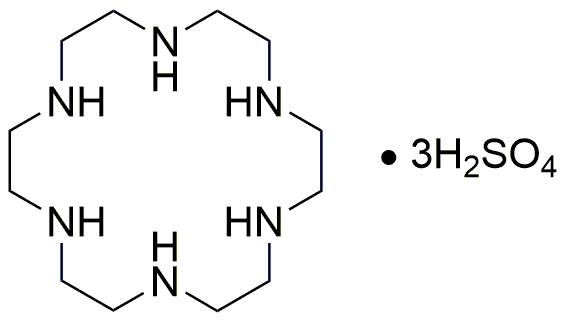Hexacyclen trisulfate is widely utilized in research focused on:
- Biomedical Applications: This compound is used in drug delivery systems, particularly for targeting specific cells or tissues, enhancing the efficacy of therapeutic agents.
- Catalysis: It serves as a catalyst in various chemical reactions, improving reaction rates and selectivity, which is crucial in the production of fine chemicals and pharmaceuticals.
- Analytical Chemistry: Hexacyclen trisulfate is employed in ion chromatography for the separation and analysis of metal ions, providing accurate and reliable results for environmental and industrial testing.
- Material Science: It is used in the development of advanced materials, such as sensors and membranes, due to its unique structural properties that enhance performance.
- Research in Coordination Chemistry: The compound is a valuable tool for studying coordination complexes, helping researchers understand metal ion interactions and their applications in catalysis and materials science.
General Information
Properties
Safety and Regulations
Applications
Hexacyclen trisulfate is widely utilized in research focused on:
- Biomedical Applications: This compound is used in drug delivery systems, particularly for targeting specific cells or tissues, enhancing the efficacy of therapeutic agents.
- Catalysis: It serves as a catalyst in various chemical reactions, improving reaction rates and selectivity, which is crucial in the production of fine chemicals and pharmaceuticals.
- Analytical Chemistry: Hexacyclen trisulfate is employed in ion chromatography for the separation and analysis of metal ions, providing accurate and reliable results for environmental and industrial testing.
- Material Science: It is used in the development of advanced materials, such as sensors and membranes, due to its unique structural properties that enhance performance.
- Research in Coordination Chemistry: The compound is a valuable tool for studying coordination complexes, helping researchers understand metal ion interactions and their applications in catalysis and materials science.
Documents
Safety Data Sheets (SDS)
The SDS provides comprehensive safety information on handling, storage, and disposal of the product.
Product Specification (PS)
The PS provides a comprehensive breakdown of the product’s properties, including chemical composition, physical state, purity, and storage requirements. It also details acceptable quality ranges and the product's intended applications.
Certificates of Analysis (COA)
Search for Certificates of Analysis (COA) by entering the products Lot Number. Lot and Batch Numbers can be found on a product’s label following the words ‘Lot’ or ‘Batch’.
*Catalog Number
*Lot Number
Certificates Of Origin (COO)
This COO confirms the country where the product was manufactured, and also details the materials and components used in it and whether it is derived from natural, synthetic, or other specific sources. This certificate may be required for customs, trade, and regulatory compliance.
*Catalog Number
*Lot Number
Safety Data Sheets (SDS)
The SDS provides comprehensive safety information on handling, storage, and disposal of the product.
DownloadProduct Specification (PS)
The PS provides a comprehensive breakdown of the product’s properties, including chemical composition, physical state, purity, and storage requirements. It also details acceptable quality ranges and the product's intended applications.
DownloadCertificates of Analysis (COA)
Search for Certificates of Analysis (COA) by entering the products Lot Number. Lot and Batch Numbers can be found on a product’s label following the words ‘Lot’ or ‘Batch’.
*Catalog Number
*Lot Number
Certificates Of Origin (COO)
This COO confirms the country where the product was manufactured, and also details the materials and components used in it and whether it is derived from natural, synthetic, or other specific sources. This certificate may be required for customs, trade, and regulatory compliance.


